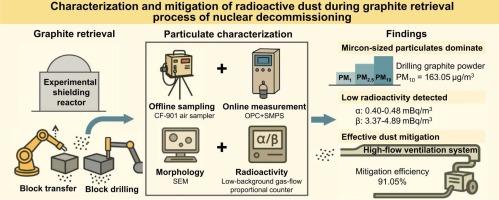核退役石墨回收过程中放射性粉尘的表征与治理
IF 11.3
1区 环境科学与生态学
Q1 ENGINEERING, ENVIRONMENTAL
引用次数: 0
摘要
核退役石墨回收过程中会产生放射性粉尘,给辐射防护和环境安全带来挑战。然而,石墨粉尘的物理化学性质和缓解策略仍然不清楚,导致其安全处理和遏制的不确定性。本研究研究了清华大学实验屏蔽反应器在石墨回收操作过程中产生的气溶胶,重点研究了封堵和钻孔过程。实验装置包括光学粒子计数器(OPCs)、扫描迁移率粒度仪(SMPS)和气溶胶采样器,以表征空气中和沉积石墨粉尘的粒径分布、形态和放射性。结果表明,钻孔过程中释放的颗粒物以微米级为主,PM10浓度超过160 μg/m3。然而,使用现场大流量通风系统(3300 m3/h)实现了90%以上的缓解效率,有效地限制了气溶胶的扩散。因此,过滤膜收集的气溶胶的放射性相对较低(α: 0.40-0.48 mBq/m3;β: 3.37 ~ 4.89 mBq/m3)。此外,源头处的除尘器进一步抑制了粗颗粒的释放。该研究为回收过程中放射性石墨粉尘的控制提供了实用数据和策略,可以提高核退役的运行安全和辐射防护水平。本文章由计算机程序翻译,如有差异,请以英文原文为准。

Characterization and mitigation of radioactive dust during graphite retrieval process of nuclear decommissioning
During graphite retrieval in nuclear decommissioning, radioactive dust can be generated, posing challenges for radiation protection and environmental safety. However, the physicochemical properties and mitigation strategies for graphite dust remain poorly characterized, causing uncertainties to its safe handling and containment. This study investigated aerosol generation during graphite retrieval operations of the experimental shielding reactor in Tsinghua University, focusing on both block removal and drilling procedures. A field-scale experimental setup was implemented, including optical particle counters (OPCs), a scanning mobility particle sizer (SMPS), and aerosol samplers to characterize the particle size distribution, morphology, and radioactivity of both airborne and deposited graphite dust. Results showed that the released particulates were predominantly micrometer-sized, with PM10 concentrations over 160 μg/m3 during drilling for powdered samples. However, the use of an on-site high-flow ventilation system (3300 m3/h) achieved a mitigation efficiency of over 90%, effectively limiting aerosol dispersion. The radioactivity of aerosols collected by filter membranes was therefore relatively low (α: 0.40-0.48 mBq/m3; β: 3.37-4.89 mBq/m3). Additionally, the dust extractor at the source further suppressed the release of coarse particulates. This study provides practical data and strategies for radioactive graphite dust control during retrieval, which can improve operational safety and radiological protection in nuclear decommissioning.
求助全文
通过发布文献求助,成功后即可免费获取论文全文。
去求助
来源期刊

Journal of Hazardous Materials
工程技术-工程:环境
CiteScore
25.40
自引率
5.90%
发文量
3059
审稿时长
58 days
期刊介绍:
The Journal of Hazardous Materials serves as a global platform for promoting cutting-edge research in the field of Environmental Science and Engineering. Our publication features a wide range of articles, including full-length research papers, review articles, and perspectives, with the aim of enhancing our understanding of the dangers and risks associated with various materials concerning public health and the environment. It is important to note that the term "environmental contaminants" refers specifically to substances that pose hazardous effects through contamination, while excluding those that do not have such impacts on the environment or human health. Moreover, we emphasize the distinction between wastes and hazardous materials in order to provide further clarity on the scope of the journal. We have a keen interest in exploring specific compounds and microbial agents that have adverse effects on the environment.
 求助内容:
求助内容: 应助结果提醒方式:
应助结果提醒方式:


